Here’s a booklet outlining the entire process of Alice in Wasteland performance. (P.s You will find the link to our YouTube video showing a documentation of the performance in the final pages of the booklet)
Author: s2443983
Creating videos of garbage
Owen and I (Vibha) created some videos of garbage on our own using items we found in the free store. This included some furry wires, stop watches, some sheets of wrap. I also bought some plastic bags. We used a DSLR camera with set lighting and a black screen to film most of our videos.
We weren’t too sure about the precise content of the videos and decided to brainstorm and experiment, and ended up filming a few interesting takes.
 Our ‘film set’.
Our ‘film set’.
I dropped some garbage bags from a height to get the illusion of jelly fish floating in the sky.
We also created a little set with garbage being dumped into a pile add to the buildup of the garbage monster.
We made miniature garbage monsters using the furry wires and dangled the stop clocks with the wire to shoot a video of a pendulum like motion to indicate time running out.
Here are the extra videos we shot:
Test runs prior to performance
We had multiple test runs to ensure that we had sufficient practice for the performance. We had a discussion regarding what sort of projector we will be using and decided on a short throw projector because we had access to back projecting screens which prevented audience’s shadow onto screen. It also worked great for space constraints. We also booked a documentation web cam, midi controllers and speakers.
The first trial run was on Friday 31st march in studio 3, Alison house:
We used the short throw projector to superimpose Xu Yi’s garbage monster onto part 2 of the performance to check for issues. we found that a black background for the garbage monster worked best, we also segregated and divided Xu Yi’s videos so that we could use them across the performance to show the garbage monster forming. We also checked how the sounds were doing with the videos, and decided we needed more practice.
The second trial run was on Monday, 3rd March at Alison house:
We checked if the screens were working well, and set up our projectors to see how we need to place the tech during the performance. We ran into a couple of problems:
1. The pico and short throw projectors didn’t work well together, the intensity of projections varied too much to fix. We decided on two short throw projectors instead.
2. The layout of the walkthrough had had multiple changes because of availability of space. So we spoke to Jules, who suggested a number of interesting ways to use the space. Our issue now was how we’d direct the viewers from panel 1 to panel 2. We decided we would use an arrow at the end of Shruti’s performance to point to the direction the audience need to walk to reach panel 2. Also while playing Xu Yi’s garbage monster videos with the Pico projector, we realised we could create a pathway projection onto the ground to lead the viewers into our space.
3. We performed our visuals with sounds twice, and we still weren’t perfect and decided to practice again.
4. Exiting from one patch to another patch for part 2 of the performance seemed a little problematic, so I(Vibha) combined two patches to make a single patch. Unfortunately when I combined the third patch, Vizzie crashed, so I stuck to having 2 instead of 3 patches. I also found simple ways of transitioning within patches for the performance.
Last trial run was on Wednesday, 5th April.
We tested the sounds and visuals by connecting our systems to monitors. The transition between patches followed a different route here, which seemed like a minor issue, but apart from that we felt confident for our performance.
27.03.23 Rehearsal with Jules and Andrew
Link to video: https://media.ed.ac.uk/media/Crit+session+for+DMSP+performance+group/1_gyc2036p
AIW showed our performance work in progress to professors Jules and Andrew for critique. They suggested we simplify the workspace (Patch) of Vizzie, max MSP, and suggested a few ways to do so. For instance, using a maximum of four players, using movie folders, and the use of some coding to trigger videos. They also suggested using more effects because the content we already had was sufficient.
For sound, they suggested more ideas for creative plastic-like sounds, such as creating sound from jelly.
We also discussed equipment usage and room allocation requirements.
Second half of visual production
Narration
The narrative approach is that Alice/the audience is now inside the rabbit hole-in an apocalyptic wasteland. But the approach to our version of wonderland is original.
The narration is simple, because we are supplementing the viewer with multiple broad videos. Alice finds herself in a plastic wasteland made of fantasy elements, all the plastic is turning into jellyfish birds flying in the sky outside a house made of mushrooms. (This is inspired by the visual approach that Tim Burton has used in 2010’s Alice in wonderland). This is partly inspired by the fact that turtles eat jellyfish, and since plastic bags look so similar to jellyfish, they often eat the plastic leading to a decline in their population. (https://www.worldwildlife.org/stories/what-do-sea-turtles-eat-unfortunately-plastic-bags)
Alice then goes forward in time to the dining scene from the same movie, except it is set in a post apocalyptic wasteland. She is then showed that she is out of time-from the dangling clock video-and then transported to a barren land filled with hills made of garbage instead of rocks. It is here that the final monster reveals itself. Unlike how Alice slayed the jabberwocky in the movie, in our version of the retelling, she fails to undo the pollution and mass destruction humankind has caused. This is because at the current rate (time/clocks) at which we are going, we will reach a time when our actions cause irreversible damage on our planet.(Thompson, R. C., Moore, C. J., vom Saal, F. S., & Swan, S. H. (2009). Plastics, the environment and human health: current consensus and future trends. Philosophical transactions of the Royal Society of London. Series B, Biological sciences, 364(1526), 2153–2166. Found online: https://doi.org/10.1098/rstb.2009.0053). Hence the only way to slay the jabberwocky, i.e, garbage monster, we must travel back to our real world and this time, make responsible choices. This is supplemented with text (below) prompting the users to do so.
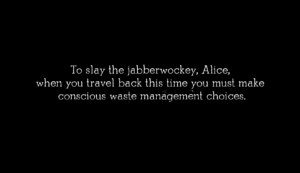
There is a portal in our performance that leads back to the first clip it starts with(My psychedelic rabbit hole portal followed by Shruti’s sunrise), forming a single loop, and hinting that Alice has left the wasteland.
Owen McDonall and I, Vibha Jayaram, filmed videos of garbage by creating a set with black curtains. Midjourney was also used to produce images with some very particular prompts, all in 16:9 ratio. These included the dining set in a wasteland, the mushroom house, and the background for monster reveal. The videos such as the spirals and the fade ins/outs were sourced through http://www.pexels.com . After effects and photoshop were used to then alter these and convert them into a video format. These videos were then mixed using mixfaders on vizzie.
I also created the poster for the performance using Midjourney and photoshop. Towards the end, I helped make the brochure as well.
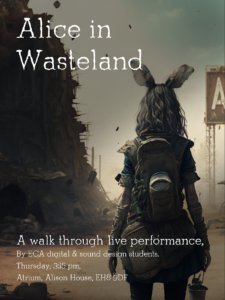
Tools used:
My work included the second half of the performance merging with Xu Yi’s garbage monster.
For that I mostly relied on Midjourney AI and videos from Pexels. I used Max MSP’s Vizzie for creating the visuals, and broke it down into two patches for better system performance. This was connected to a MIDI controller. I used a short throw projector on a back projecting white screen for the performance. Additionally, Owen and I shot some videos on his camera using a set we created using materials we sourced from ECA free store.
.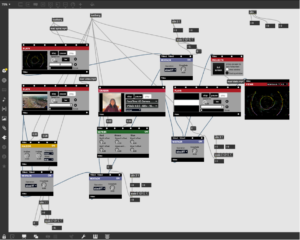
This is my first patch (I was trying to create a psychedelic transition into garbage land using kaleidoscopic effects and a camera (IPEVO documentation camera)
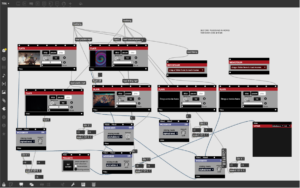
This is my second patch
Challenges
The beginning and end of my performance had to merge with Shruti’s visual and narrative approach. Since we were building something that formed a loop, we decided to loop the rabbit holes, which were a perfect way to break and remix the visuals. Hence, we had a rabbit hole at the beginning, and at the part where the garbage monster began forming and at the end of the performance.
I also had to effectively make vizzie patches that could run on my system without crashing, so I used movie folders as per the professor’s guidance. Unfortunately, I had to use two patches and switch between them during the performance. This was because I wanted specific effects on specific videos, and if combined, my system started crashing. This was a little tricky, because each time we practiced, I had to come up with a slightly different way to switch between patches seamlessly, and quickly turn the midi controllers to their set positions on time when the second patch started playing. It also required concentration and practice to switch between movie folders on time and remember the midi controller positions that operated the particular files.
The performance day
We had many instantaneous ideas on the performance day to build monsters out of the garbage we had gathered, and tie up bags on the entrance to give more character to the installation space. However, because of how dark it was, these details weren’t entirely visible. Mengru Liu had the idea to add candle lights to the monsters we made which made them more visible.
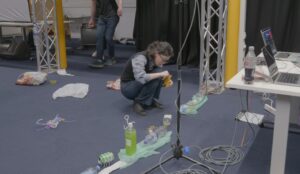
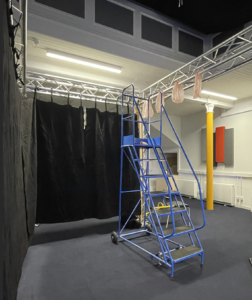
It took a lot of time for us to set up the room and get everything working. But right before the performance, my projector started malfunctioning. We had all just set up to do a trial run when a loose connection to my laptop caused the projector to project a blank screen and when I tried to fix that, it progressively got worse. It took around half an hour to get my projector to work but it was displaying the branding in big bold letters. Hence Xu Yi and I had to make the decision to merge our parts and play the visuals from one projector (her’s) instead of two.
Regarding the visuals, we were instructed to blend my parts with Shruti’s a little more, and we added the sunrise video to the end of my performance which worked great.
Reflections
We could have brought a few more bags of garbage and made an installation wall if we had time.
I learnt that one should always check if the tech is working first and then set up the space second.
Something will always go wrong and it’s good to have a backup.